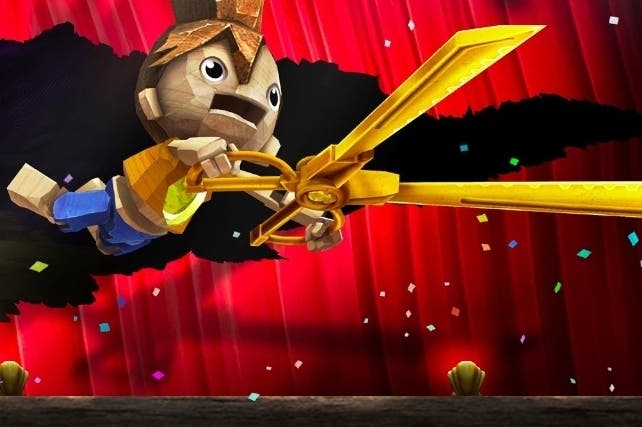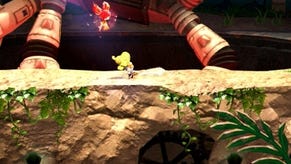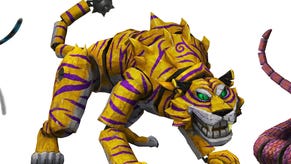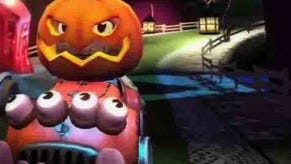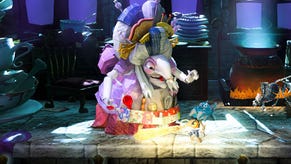Puppeteer review
String theory.
Sometimes all it takes is one great idea. In that regard, Puppeteer, by Sony's Japan Studio, is off to a strong start. It has several great ideas. Sadly, it doesn't seem to know what to do with them.
It's the story of Kutaro, a small boy imprisoned on the Moon. He's transformed into a puppet and then loses his head. Luckily, as a wooden puppet, he can simply replace his head with a new one - but if he spends too long without a noggin, he's dead. Fortunately, he has help.
Enter idea number one: a secondary character - a floating cat in the first levels, replaced by a fairy-esque creature called Pikarina for the remainder of the game. This character is controlled with the right stick, or by a second player, and can interact with Puppeteer's busy backgrounds. Jiggling objects and prodding things shakes loose shiny moonsparkles - 100 of these grant an extra life, naturally - or a new head for Kutaro to wear.
Cue idea number two: a main character with dozens of interchangeable heads. Kutaro can wear everything from a spider to a pistol to dinosaur in place of his misplaced bonce. The downside? None of these heads make any difference to the gameplay. Rather than performing any practical function, each head offers only a special "action" which only has an effect if you do it in a specific place.
A floating image of the relevant head tells you which one to use, and performing the action from the correct head at that point triggers something. It might be a bonus level - a time-limited scramble to collect moonsparkles - or it might be a wheel of fortune where you have a one-in-three chance of being killed. Very rarely, the head actions will result in a tangible benefit, helping you past a particular obstacle or boss fight.
Beyond that, it doesn't matter which head you use, but then nor do you get much choice. You can carry three heads at a time, swapping between them as you wish. Any new head immediately replaces the one you're wearing, and heads can be knocked off and lost if you take a hit and don't retrieve it before it rolls away. In other words, all these weird and wonderful body parts, any one of which could take the gameplay in exciting new directions, is little more than an extra life.
That's probably Puppeteer's biggest missed opportunity, but nor does it make much better use of its third big idea: Calibrus. That's the name given to a magic pair of giant golden scissors that Kutaro earns during the first of the game's seven acts. Snipping away with Calibrus allows Kutaro to defy gravity, providing there's something snippable for him to follow. Banners and flags provide obvious aerial routes, but Puppeteer's hand-crafted visual style also allows for paper and card moving elements - clouds of smoke, trails of feathers - to act as traversable terrain. Sometimes you'll come across a seam - a line of stitches that Kutaro can whizz along for rapid transit.
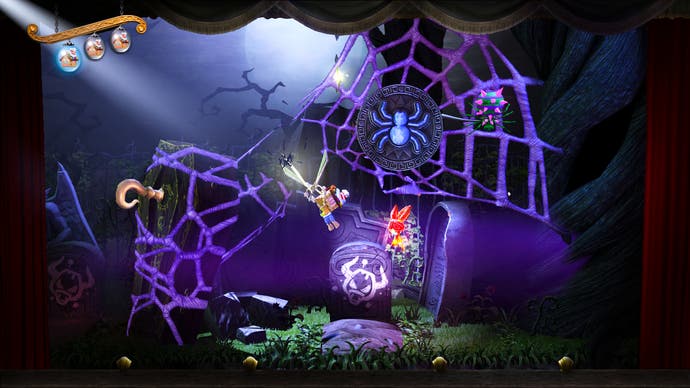
It's a fantastically tactile interaction, but as with the interchangeable heads, it's a potentially fruitful gameplay idea that never evolves. Come the end of the game, you'll still be snipping the exact same objects for the exact same effect as you did right at the start.
There's no sense of evolution or escalation; Puppeteer constantly feels on the verge of blossoming into something richer and deeper, but never quite gets around to it. Strip away the lovely theatrical staging, with its dynamic scenery changes and boundless energy, and look past the charmingly detailed wooden characters, and you're left with a fairly ordinary platform game. For all the arts and craft materials it evokes in its appearance, there's no glue holding it all together.
Puppeteer obviously resembles LittleBigPlanet in terms of its aesthetic, but it also feels a lot like Sackboy's adventures, with floaty physics and fuzzy collisions. Where Media Molecule's game compensated with innovation and customisation, Puppeteer instead falls back on repeating the same level designs multiple times - side-on chases, spiral ascents and button-mashing boss battles that use the same patterns over and over. The level design rarely surprises, and death often comes from seemingly simple jumps that prove annoyingly fussy, or from the busy staging masking some fatal obstacle or enemy.
Puppeteer comes frustratingly close to delivering something special. But despite multiple gameplay avenues bursting with potential, it leaves them largely unexplored

It's also an exhaustingly verbose game, often foregrounding its script at the expense of the player. Platform gaming is a genre that typically cuts to the chase with the minimum of fuss, yet Puppeteer opens every stage with two lengthy cut-scenes - between five and 10 minutes' worth - and then keeps yakking, leaving the mute, expressionless Kutaro to one side while its supporting characters bicker with each other. It's not that the script is bad - it's actually very witty and amusingly voiced - but it's too much for such a slender gameplay frame to support.
This certainly isn't a bad game, but it is a disappointing one. Visually, it's a treat and, Kutaro's inevitable blankness aside, it overflows with personality. It comes frustratingly close to delivering something special. But despite multiple gameplay avenues bursting with potential, it leaves them largely unexplored, showing more interest in wowing you with surface sizzle. Arriving in the shadow of the brilliant Rayman Legends certainly does Puppeteer no favours, and by the time you reach the end, its fragile whimsy has been stretched far too thin.
